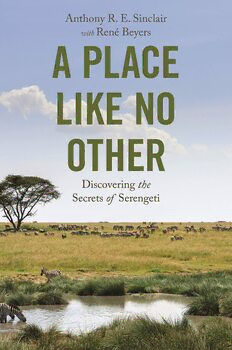
A Place like No Other: Discovering the Secrets of Serengeti PDF
Preview A Place like No Other: Discovering the Secrets of Serengeti
A Place like No Other A Place like No Other discovering the secrets of serengeti ANTHONY R. E. SINCLAIR WITH RENÉ BEYERS prince ton university press prince ton & oxford Copyright © 2021 by Prince ton University Press Prince ton University Press is committed to the protection of copyright and the intellectual property our authors entrust to us. Copyright promotes the pro gress and integrity of knowledge. Thank you for supporting free speech and the global exchange of ideas by purchasing an authorized edition of this book. If you wish to reproduce or distribute any part of it in any form, please obtain permission. Requests for permission to reproduce material from this work should be sent to permissions@press . princeton . edu Published by Prince ton University Press 41 William Street, Prince ton, New Jersey 08540 6 Oxford Street, Woodstock, Oxfordshire OX20 1TR press . princeton . edu All Rights Reserved Library of Congress Cataloging- in- Publication Data Names: Sinclair, A. R. E. (Anthony Ronald Entrican), author. | Beyers, René, 1961– author. Title: A place like no other : discovering the secrets of Serengeti / Anthony R. E. Sinclair with René Beyers. Description: Prince ton : Prince ton University Press, 2021. | Includes bibliographical references and index. Identifiers: LCCN 2020056501 (print) | LCCN 2020056502 (ebook) | ISBN 9780691222332 (hardback) | ISBN 9780691222349 (ebook) Subjects: LCSH: Animal ecology— Tanzania— Serengeti National Park Region. | Ecosystem management— Tanzania— Serengeti National Park Region. | Biodiversity conservation— Tanzania— Serengeti National Park Region. | Serengeti National Park (Tanzania) Classification: LCC QL337.T3 S56 2021 (print) | LCC QL337.T3 (ebook) | DDC 591.709678/27—d c23 LC rec ord available at https:// lccn . loc . gov / 2020056501 LC ebook rec ord available at https:// lccn . loc . gov / 2020056502 British Library Cataloging- in- Publication Data is available Editorial: Alison Kalett and Whitney Rauenhorst Production Editorial: Natalie Baan Jacket Design: Layla Mac Rory Production: Danielle Amatucci Publicity: Kate Farquhar- Thomson and Sara Henning- Stout Copyeditor: Steven Krauss Jacket image: Zebras grazing in the Serengeti, Tanzania. Photo: James Smith / Alamy Stock Photo This book has been composed in Arno Printed on acid- free paper. ∞ Printed in the United States of Amer i ca 10 9 8 7 6 5 4 3 2 1 In recognition of Justin Hando 1951–2020 and Markus Borner 1945–2020 Who, in dif er ent ways, saved the Serengeti in its time of greatest need contents Preface ix Acknowl edgments xiii 1 Why Serengeti? 1 2 The Discovery of Rinderpest 25 3 Finding Regulation 33 4 The Discovery of Food Regulation 44 5 How Predators Regulate Prey 59 6 How Migration Structures Serengeti 74 7 Biodiversity and the Regulation of Ecosystems 89 8 Disturbance and the Per sis tence of Ecosystems 106 9 Continuous Change in Ecosystems 115 10 Appearance of Multiple States and Rapid Shifts in Ecosystems 133 11 The Fundamental Princi ple of Regulation, and Future Directions 143 vii viii contents 12 Threats to the Serengeti 155 13 Lessons from the Serengeti 172 14 Rewilding 193 Appendix: Mammals and Trees Mentioned in the Text 219 Notes 225 Index 271 preface This is the narrative of how scientists discovered the rules that produced the unique features of the great Serengeti ecosystem and allowed it to persist. The story begins when I, Anthony Sinclair, first arrived in the Serengeti as a young student in 1965, and, seeing the magnificence of the place, de cided to find out why it was so outstanding and what held it together and made it work. My first job, as an assistant to an Oxford University professor, was to answer the question of how so many mi- grant birds from the whole of Asia and Eu rope had managed to fit into the comparatively tiny area of East Africa for the winter—t hey seemed to be breaking all the rules of ecolo gy. While engaged with this prob lem, I became aware that the large- mammal populations of Serengeti were increasing rapidly, especially the dominant herbivore species of bufalo, wildebeest, and elephant. I was asked to turn my attention to this prob- lem. The increase raised a number of questions fundamental to ecol ogy and essential for conservation. I started with this s imple question: Why w ere these species increas- ing? But this led to more profound questions and discoveries. Perhaps once a de cade since then, there has been an impor tant discovery con- cerning some new aspect that explains how the Serengeti works. Th ese aspects are really all related to one fundamental princi ple— the princi- ple of regulation— which governs not only Serengeti but also every other ecosystem of the world. It turned out there were seven of these aspects, which we called subprinciples, uncovered over a period of some 50 years (see chapters 3–10). The story of their elucidation is necessarily linear, and for the most part that is how the princip les w ere uncovered— one discovery led to more questions, which led to the next discovery. The princi ple of regulation (chapter 3) was deduced in the 1960s and ix
